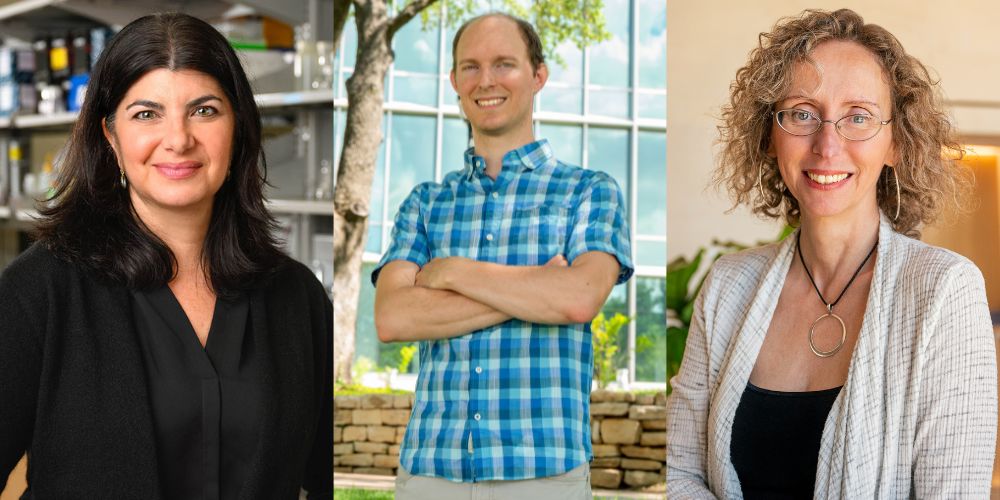UTA biologists address global extinction crisis

Brook trout are disappearing from American streams. Amphibian habitats are changing. Coral species are dying.
As the global climate changes at accelerating speeds, nature is restructuring itself. Some species thrive. Others die off. Biodiversity, the unique variety of species on our planet, is reeling.
According to a 2019 United Nations report, climate change has increased the risk of extinction for nearly 1 million plant and animal species. Climate-driven increases in disease, habitat reduction and the prevalence of warm temperatures threaten species’ survival and compromise the integrity of ecosystems around the world.
On land and underwater, biologists at The University of Texas at Arlington are tackling the extinction crisis and finding sustainable solutions that promote healthy ecosystems.
Diseased Caribbean corals
Laura Mydlarz, professor of biology, estimates that 30% to 50% of coral species in the Caribbean Sea are in danger of extinction. Many of them suffer from diseases that have increased because of climate change.
To protect these dying ecosystems, her lab studies coral immune responses to white plague disease, stony coral tissue loss disease (SCTLD) and black band disease.
SCTLD is a highly contagious disease that rapidly kills coral tissue. Once a single polyp becomes infected, a coral’s colony could die within weeks to months, research shows, leaving behind only the animal’s white skeleton. The origin of SCTLD is poorly understood, and its pathogen is unknown, preventing researchers from understanding its transmission and effective treatments.
A study published by Mydlarz’s lab revealed the discovery of DNA evidence of viruses in SCTLD-affected coral colonies. The team’s data will support researchers’ critical next step of characterizing the presence and absence of viruses across Caribbean coral colonies, and further clarify the potential role of viruses in SCTLD.
“This is a promising development that will advance our knowledge of infectious coral diseases and ways to prevent them,” Mydlarz said. “Understanding SCTLD will help researchers and reef managers protect coral habitats and the biodiversity that they support.”
Amphibian habitat loss
Luke Frishkoff, assistant professor of biology, wants to understand how human impacts on the environment affect species’ risk of extinction.
To help target and prioritize the conservation of species at greatest risk, Frishkoff investigated the impact of habitat loss on amphibian populations from across the globe. The primary objective was to understand how species’ traits inform responses to habitat conversion.
Using data from 18 studies of 154 species, Frishkoff’s team discovered that arboreality, the quality of living in trees, leads to species’ increased sensitivity to habitat conversion. Additionally, the relationship of amphibians’ reproductive processes to water sources was a major determinant of how they would respond to habitat change. The team’s findings also supported the conclusion that the winners and losers of habitat conversion are often dictated by heat tolerance. Species with higher tolerance are more likely to survive among human-altered habitats.
“Preserving biodiversity hinges on our ability to identify the species that are most sensitive to human-caused changes, particularly habitat conversion and climate change,” Frishkoff said. “Improved predictability of species sensitivity allows us to identify and protect areas that contain the most vulnerable species.”
Biodiversity loss in freshwater systems
Research by Sophia Passy, associate professor of biology, focuses on the biodiversity of America’s freshwater ecosystems. Rivers, lakes and wetlands contain inordinately high species diversity while composing very little of the earth’s surface area. These traits make their ecosystems especially vulnerable to climate change.
A study by Passy’s lab examined how varying degrees of greenhouse gas emissions could impact species distributions in streams across the United States. Using data on 336 species of algae, insects and fish from 1,227 streams, the team predicted distributional changes that could occur by the years 2050 and 2070.
Passy predicts that climate change will cause a widespread expansion of warm-water species, many possessing characteristics of environmental concern, such as invasiveness, hybridization and threat to water quality. At the same time, cold-water species are projected to decline. Recreationally important species, including brook trout, are projected to lose more than 80% of their current distribution.
“When freshwater systems suffer, humans suffer too,” Passy said. “Given that the magnitude of community rearrangement depends on the severity of climate change, there are still environmental policies our government could implement to protect the health and integrity of the nation’s stream ecosystems.”